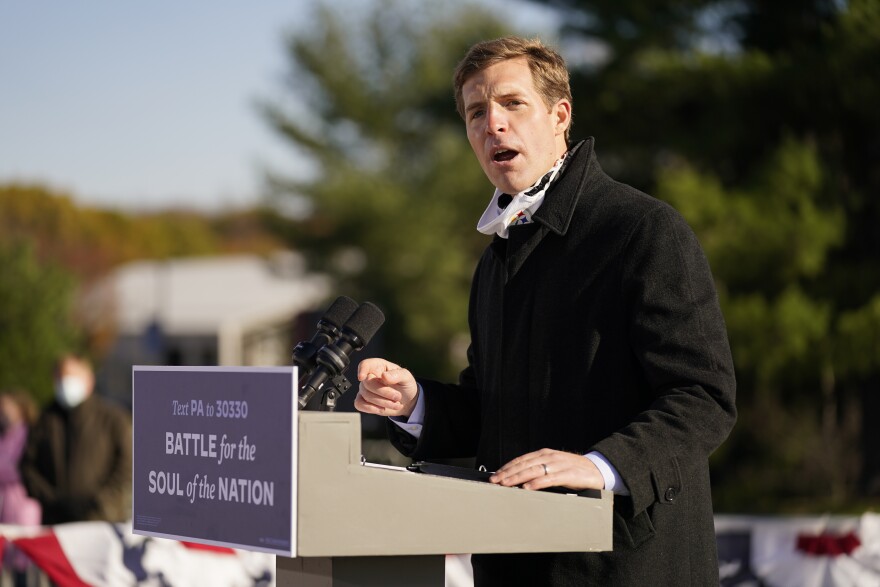The contest to replace outgoing Republican U.S. Sen. Pat Toomey — one of the most closely watched Senate races in the country — is well underway. Dozens of candidates have announced bids for the seat, and several with national name recognition have raised millions to fund their efforts.
But how much a candidate raises isn’t the only number to pay attention to: It’s also important to look at where the money comes from. And some Senate hopefuls — like Democratic Lieutenant Governor John Fetterman and Republican Jeff Bartos — have drawn much of their strength from inside the state.
“In the case of Pennsylvania you have an open seat and obviously a 50-50 Senate,” said Brendan Glavin, a senior data analyst at OpenSecrets. “That’s going to garner a lot of national attention. And if people see the race as competitive or people have been told the race is going to be competitive, then you’re going to see a lot of outside money from around the country flowing into the race.”
But big fundraising numbers don’t directly translate into people who can actually vote in Pennsylvania next year.
Glavin points to examples like South Carolina Democrat Jaime Harrison, who broke records when he raised $57 million in the third quarter in 2020 but lost his race to Republican Lindsey Graham by 10 percentage points. The fundraising total “creates an illusion of support that maybe is not actually there among the voters,” Glavin said.
On the left
In what’s sure to be an expensive race, candidates with national name recognition — including Democrats John Fetterman and Conor Lamb of Western Pennsylvania — have raised more money than most candidates so far. Fetterman, whose efforts as the mayor of Braddock drew national press attention and who has grown a large following on Twitter, has raised more than $6 million since he launched his campaign in February and has spent more than half of what he’s raised. Of the 13,448 individual donations to Fetterman’s campaign so far, 61% were made by Pennsylvanians.
Lamb, who gained a national following of his own during his 2018 special election win against Republican Rick Saccone, has reported raising more than $1.4 million since entering the race this summer. 43% of his 1,332 donations were made by donors in the Commonwealth.
Among Democrats from the Eastern side of the state, Montgomery County Commissioner Val Arkoosh has raised roughly $1 million to date, and 61% of her 1,090 donations have come from Pennsylvanians. 92% of the 230 donations to state Sen. Sharif Street’s campaign were from inside the state, though he’s pulled in just under $250,000 so far. Another Philadelphian, state Rep. Malcolm Kenyatta, outraised him — reporting $876,639 so far this year — but Kenyatta had the lowest share of in-state contributors of any major candidate, with about 37% of the 916 individual donations coming from Pennsylvanians. Kenyatta's campaign has boosted his profile by noting that he could make history as an openly gay Black man running for Senate.
WESA’s analysis of in-state versus out-of-state contributions is limited to itemized contributions — in which a donor has given at least $200 in total to a candidate. That means many small-dollar donations — often made through sites like ActBue and WinRed — were not analyzed, since that data isn’t accessible. Experts note that small-dollar donations tend to tilt the balance to more out-of-state donations, especially as a campaign wears on: The fundraising platforms allow candidates to capitalize on national headlines by sending email blasts to givers on nationwide donor lists.
Glavin notes that federal officeholders like Lamb — who travels and works outside Pennsylvania more frequently than state officials do — are more likely to have out-of-state support.
“Incumbent candidates in the House or the Senate, they’re spending a lot of time fundraising,” Glavin said. “You know, you’re inside the Beltway, you tend to see that they get a lot of contributions from the District of Columbia, from Maryland, Virginia.”
“[Lamb] has been raising money as a House incumbent. But for the other candidates that don’t have that presence outside their own state, you expect it to be a little more equal,” Glavin said.
On the right
On the Republican side, GOP candidate Jeff Bartos, who ran unsuccessfully for lieutenant governor in 2018, has outpaced his rivals in fundraising numbers. The businessman reported nearly $2.2 million in donations so far. 81% of the 605 donations to his campaign came from in-state supporters, the highest percentage for all candidates who have reported major fundraising numbers so far.
The other top two Republican candidates raised just a quarter of Bartos’ total through June 30. Republican Kathy Barnette, who has come under scrutiny for her ties to QAnon and efforts to promote false claims about voter fraud in the 2020 election, raised just over $600,000, with 78% of her 528 donations coming from Pennsylvanians. Reports from Western Pennsylvania Republican Sean Parnell, who lost his U.S. House race to Lamb last year, show he’s raised about $561,000. Parnell has a national profile as a writer and a frequent commentator on Fox News. WESA's analysis shows that just 43% of his 731 donations came from Pennsylvanians.
Glavin noted that even though it’s early, those in-state contributions can be useful to examine.
“If you have two candidates that are essentially raising the same amount of money, but one is much more heavily weighted in-state versus out of state, then I think that shows the likelihood that the candidate….has more support on the ground. How that plays out in the end is a different story, but it’s something worth looking at.”




